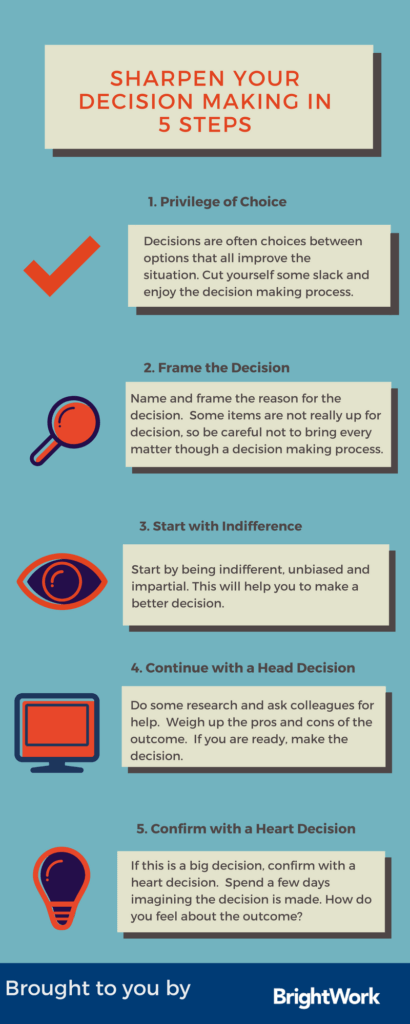Making effective decisions is key to collaborative project management. Using a process will allow you to make decisions more effectively. I suggest a five-step approach as follows:
- Remember the Privilege of Choice.
- Frame the Decision.
- Start with Indifference.
- Continue with a Head/Logical Decision.
- Confirm with a Heart Decision.
The essence of this approach is presented as an infographic with more information on each step below.
Sharpen Your Decision-Making in 5 Steps
1. Remember the Privilege of Choice
We can sometimes feel burdened by pending decisions and this is understandable. However, many times the decisions represent choices between options that all improve the situation. In these cases, it is important to cut ourselves some slack and enjoy the decision-making process.
Remember that in many situations, we are electing which path to follow – it is our choice. In decision making, try to enjoy the freedom of choice and free will that we have.
2. Frame the Decision
Name and frame the reason for the decision. Remember that some items are not really up for decision, so be careful not to bring every matter through a decision making process. For example, you are behind on the project and you would like to bring on two more people to the project, but your sponsor has explicitly said that the resources at this stage of the project are fixed. Save yourself and others the energy and stress.
At this stage, decide if there really is a decision to be made.
3. Start with Indifference
Sometimes the decision is not obvious; you need time and a decision-making process.
If you need time to make the right decision, do not start with the decision already made in your head. Start by being indifferent, unbiased, and impartial. If this is a project related decision, remind yourself of the project objectives or goals.
If this is a personal decision, be mindful of your own goals and values. This level of detachment can be difficult but it is important and will help you to make a better decision.
4. Continue with a Head Decision
You can continue the decision-making process with a logical approach. Some suggested steps follow:
- Do some desk research.
- Ask for help with the decision. Consult with those involved and LISTEN. Get other perspectives – but be mindful that you may be still making the decision yourself.
- Layout and weigh up the pros and cons. List the advantages or benefits of each choice. Also, list the disadvantages or potential damages of each option.
- Make a reasoned decision.
After the research, consultation, and analysis, if you are sure that the decision is right and obvious, then run with it. Communicate the decision and the rationale to those involved. Take the actions that the decision warrants.
If this is a big decision, do not confirm the decision immediately. Instead, pause and confirm with a heart decision.
5. Confirm with a Heart Decision
It can happen that you have to make a big decision but you have the luxury of a few extra days. And for important decisions, you should take the extra time.
After you make the reasoned decision following a process like the one above, you can sit with the decision and see if you still feel mostly positive about the decision after a few hours and a few days – not just immediately.
Over these days, assume the decision is made and imagine what it is like to live with that decision. Listen to what your heart is telling you. Follow your feelings (the good and the bad) and try to understand them. Do not go final on the decision, when you feel bad about it. Let it settle.
You can also use the “other person” technique to check difficult decisions. Imagine you are advising someone you love, respect, and want the best for. What advice would you give this person who was at this stage of the decision-making process?
Editor’s Note: This article is an excerpt from our free book, Collaborative Project Management: A Handbook.

